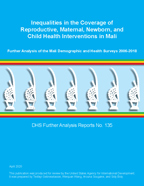- PUBLICATIONS
- JOURNAL ARTICLES
- ACCESS PUBLICATIONS
Publications Summary
- Document Type
- Further Analysis
- Publication Topic(s)
- Child Health and Development, Family Planning, Maternal Health, Wealth/Socioeconomics
- Country(s)
- Mali
- Survey
- Mali DHS, 2018
- Language
- English
- Recommended Citation
- Gebreselassie, Tesfayi, Wenjuan Wang, Arouna Sougane, and Sidy Boly. 2020. Inequalities in the Coverage of Reproductive, Maternal, Newborn, and Child Health Interventions in Mali: Further Analysis of the Mali Demographic and Health Surveys 2006-2018. DHS Further Analysis Report No. 135. Rockville, Maryland, USA: ICF.
- Download Citation
- RIS format / Text format / Endnote format
- Publication Date
- April 2020
- Publication ID
- FA135
Download
 Inequalities in the Coverage of Reproductive, Maternal, Newborn, and Child Health Interventions in Mali (PDF, 760K)
Inequalities in the Coverage of Reproductive, Maternal, Newborn, and Child Health Interventions in Mali (PDF, 760K)
Download this publication
There is no printed copy available to order.
